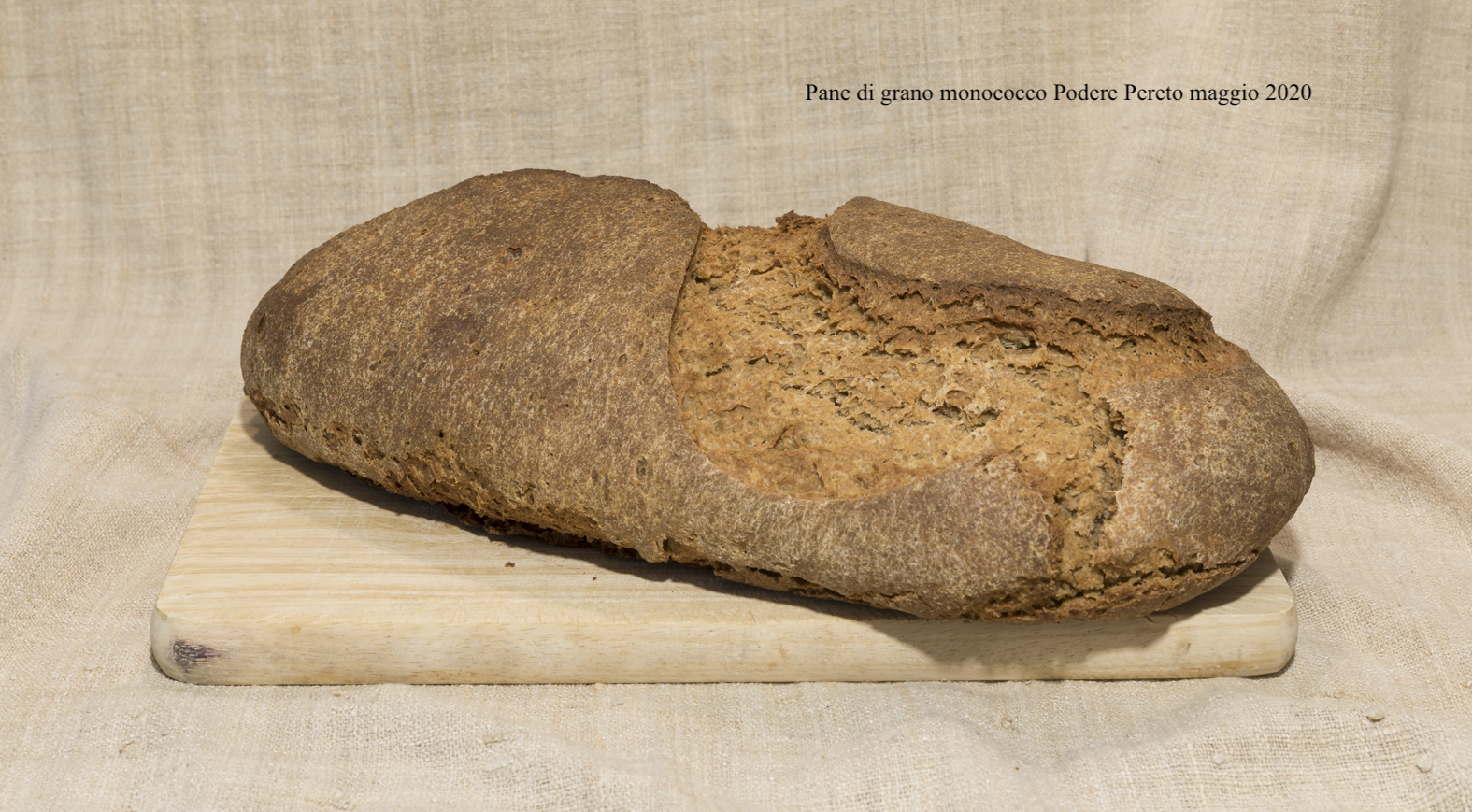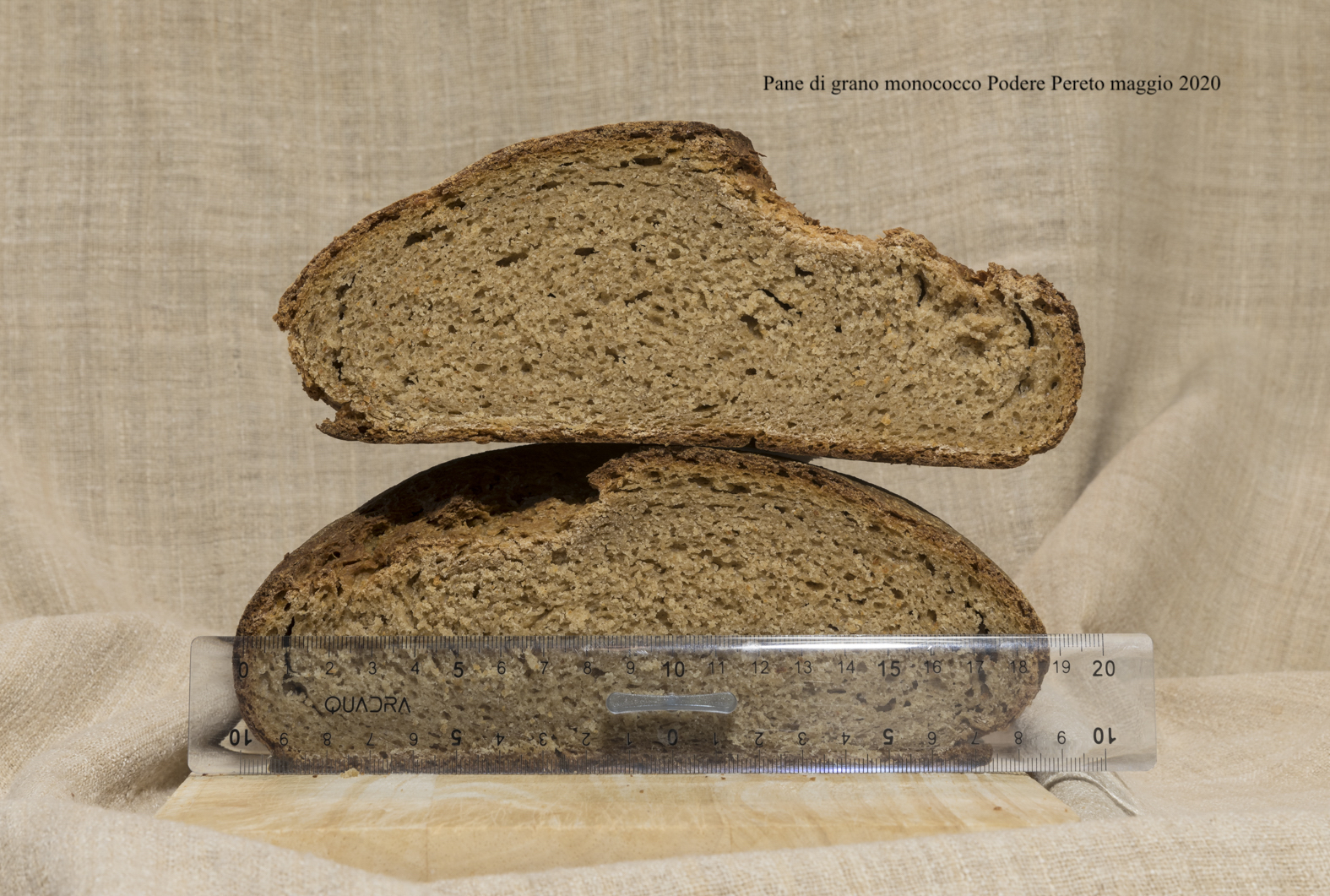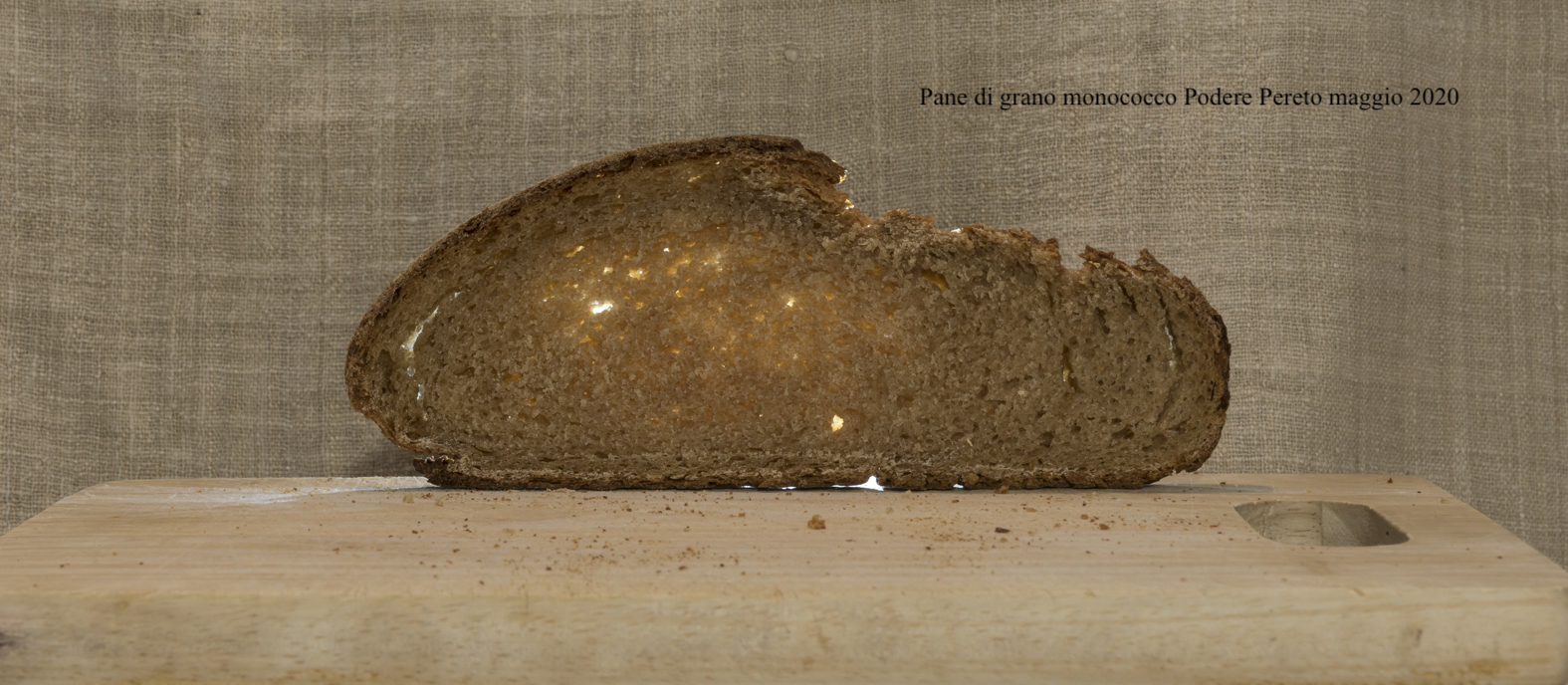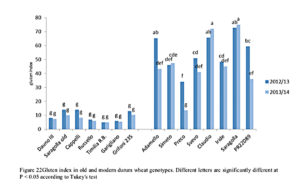New test with indirect method to obtain a einkorn wheat bread with very high digestibility and tolerability. (suitable for non-celiac gluten / wheat sensitive people).
Introduction
This test follows the one presented on 27th -September -2019: https://glutenlight.eu/en/2019/09/27/einkorn-bread100/
From that presentation we take all the introductory part that remains unchanged. “Scientific research has long highlighted, in addition to the great digestibility and richness of mineral contents, also the high tolerability of some varieties of einkorn wheat (https://glutenlight.eu/en/2019/03/11/tolerability-of-the-monococcum-wheat/).
For this reason we dedicate particular attention to this grain.
In summary some of the possible difficulties are:
1. The least amount of gluten
2. The lower strength of gluten
3. Damaged starch (1)
4. Amylase too weak (falling number greater than 350). (2)
Furthermore, the creation of products for people who are sensitive to gluten / wheat but not celiac requires long maturation times for the dough so that the enzymatic processes also operate the transformations (hydrolysis) of starches and gluten (https://glutenlight.eu/en/2019/03/12/maturation-and-fermentation-of-a-mixture-of-water-flour-and-yeasts-and-or-lactic-bacteria/).
Long maturation times (over 24 hours) are not compatible with the stability of this type of dough at room temperature or above. Low temperature (4-6 degrees) a retarder prover (cold rooms for leavening control) must be used to slow the leavening and to help the maturation of the dough (or, for home preparations, the refrigerator). Once the maturation is over, it will then proceed rapidly to leavening/proofing. It must be used, because the product is designed for people sensitive to gluten / wheat but not celiac, the sourdough of the same grain we use or the most digestible and tolerable einkorn wheat. This sourdough will not give great contribution to leavening. Furthermore, the lack of gluten does not generate an abundant nor strong gluten network: we risk having a low and compact bread. You will have to introduce air into the dough during preparation.
You will have to use a very limited percentage of fresh compressed Brewer’s yeast that has the function of starter and collaboration with the lactobacilli. The flour to be used should always be from organic cultivation. The use of nitrogen compounds increases both the percentage of gluten and strength and alters the glutenin gliadin ratio. (https://glutenlight.eu/en/2019/03/14/fertilizers-and-wheat/). These notes are part of a new industrial method for making dough for bread and dry products suitable with gluten-poor flours (limited percentage of gluten and limited “gluten strength”). They are the flours that, in current practice, are not used for the production of bread.”
Method chosen: this test is carried out using the pre-ferment followed by the final dough.
Furthermore the method was adapted for a home preparation, so without the use – for example – of a a retarder prover.
Times and temperatures have been defined for a semi-wholemeal einkorn flour (a flour through a 600 micron sieve), stone-ground flour, produced by “Podere Pereto Rapolano Terme Siena, 2019 harvest. This clarification is necessary, because especially times and temperatures vary according to the flour (type and harvest) and its degree of refining (quantity of bran present). The method is for expert people”.
The purpose of test
The purpose of this test is to try to reach the limit of tightness of the dough so consequently the lactobacilli of the sourdough can hydrolyze (break) as much as possible the gluten to make it more digestible and tolerable. Beyond this limit we have the total disintegration of the glutinic network. The product obtained is a bread suitable for people (NOT CELIAC PEOPLE) who have a lot of difficulty with gluten.
Obviously it is possible by decreasing, for example, the fermentation time from 21 hours to 18 in order to have a less hydrolyzed dough obtaining an absolutely excellent bread. The “W” index of this flour is modest, placing itself below the value of 50. This means that the dough has little stability and develops a limited and weak glutinic network. I remember that in all the doughs made with flours with little “strength” it is essential to be able to introduce air into the dough which, during the cooking phase, will help to make the crumb non-compact.
Ingrendients
Idratazione 60% 900 =540gr. (effettiva con 45 acqua licoli = 585gr. pari al 65% circa)
|
preimpasto |
impasto |
|||
|
1 |
Farina |
400gr. |
500gr. |
|
|
2 |
Acqua |
180gr |
540-180 =360gr. |
260 + 100 (-20gr)* |
|
3 |
LiCoLi |
90gr. |
0 |
|
|
4 |
L. di B. |
0,8gr.+10gr. acqua |
0,8gr.+10gr. acqua |
|
|
5 |
Malto |
0 |
10,8gr. |
1,2% di 900gr. |
|
6 |
Sale |
0 |
16,2gr. |
1,8% di 900gr. |
|
11gr. |
38gr. |
|||
|
681gr. |
898gr. |
|||
* this value is variable depending on the moisture content of the flour and also on the degree of wheat grinding, in the test carried out the amount of water added in the final phase (5 steps) was, precisely 80gr. instead of 100gr. that was the standard average value to use.
Steps
1 step: refresh the sourdough – made with Podere Pereto einkorn wheat- as liquid batter (Li.Co.Li.) not as stiff dough twice in a row and use it well mature (preparation times vary depending on the room temperature, on average 4 hours + 4 hours). Li.Co.Li. should be stored (as a precaution) in the refrigerator and, therefore, before cooling it, it should be kept for at least 1 hour at room temperature.
2 step: prepare the preferment with 400gr. flour and 180gr. of water, both cold (from the refrigerator), 90gr. of LiCoLi and 0.8gr. of fresh compressed beer yeast dissolved in very little non-cold water. The preferment should be mixed unstrung, it must not be wet or dry but lumpy pasty. The temperature of the pre-mix at the end of the preparation must be around 18C °.
3 step: put the pre-dough in a plastic bowl (lightly greased with seed oil) covered at 18 ° C for 12 hours.
4 step: after 12 hours, place the pre-dough in a mixer / mixer bowl, add 260gr. of water and use a blade blender to dissolve it and incorporate a lot of air (perform with care). Now add the malt (10.8gr.), the yeast (0.8gr.) and blend again (about 5 minutes).
5 step: now using the planetary mixer with the hook, add all the flour still available and 80gr. of water to the mixture referred to in the previous step (it is not necessary to mix completely ). If there is flour left in the bottom of the bowl, add a little water, very very little. In this test, done with twice the amount of flour and, consequently, twice as much as any other ingredient, i used the Mecnosud Mamy Forcellina 7 mixer for this phase with speed 4 and time 10 minutes.
6 step: and complete by hand to homogenize.
7 step: then put the dough in a covered plastic bowl (lightly greased with seed oil) in the fridge for 21 hours checking that the temperature of the dough does not exceed about 18 degrees so that the dough ripens in the cold but little, very little yeast; the leavening will take place later (in this test I used a retarder ).
8 step: take the bowl from the fridge and put it with its lid on a hot surface (the one used in the rotisseries) heated to 30 degrees for 2 hours or more (the dough on the surface should reach a temperature of about 18/19 degrees ). In this test: 2 hours.
9 steps: pour the dough on a pastry board lightly greased with seed oil (resting on the warm surface), manipulate (make folds) the dough for about 2-3 minutes. Give it the shape of a “loaf” and place it in a leavening basket type banneton (covered with baking parchment paper). Place the basket in a closed plastic bag (it is used to keep the dough moist and not to dry out the surface) and put it on a hot surface at 30 degrees for about 1 hour or as much as needed for the proofing. In this test: 1 hour and 30 minutes.
10 step: place the dough with his baking parchment paper on a baking sheet and bake. You can also spill off the loaf over on the baking tray; I use this mode if the surface of the dough has many cracks. Make cuts on the surface as long as the dough is not too leavened or too hydrated.
11 steps: average cooking time 1 hour and 10 minutes (depending on the type of oven). Static cooking, possibly with a water pot inside for 1 hour; last 10 minutes naked loaf on the grid in the oven (the bottom of the loaf should still be slightly soft). In these 10 minutes the loaf will grow a little bit again.
Result: a bread with always different aromas and flavors full of the “hints” of the wheat used. Characterized by a light acidic note that accompanies its flavor thanks to the fermentation carried out by the sourdough. Acid fermentation which gives the bread digestibility and high tolerability.
A bread without gummy notes and with a long shelf-life. No additives, no improvers like all the loaves presented on this site. A bread with a rough crust and a good crumb present despite the fact that this flour – almost wholewheat – has little gluten and is rather weak. With this method if we we get to hydrolyze almost all gluten we will get a “crumbly” bread!
Note:
1 – step n. 4, 5, and 6: total time approximately 30 minutes
2 – the flour and water must have a temperature so that the dough has a temperature of about 18 degrees at the end of the 6th step.
3 – NEVER use dusting flour but anoint hands and pastry surface with very little seed oil.
4 – Doughs with flours with weak and low gluten have a gluten network with limited stability and strength. By heating the dough from below we preserve the surface a little from the early breakages.
5 – If the dough after refrigerator time has a broken surface, reduce the time of step n. 7 from 21 to 18 hours.
6 – The dough with einkorn flour in long maturations tends to release part of the water absorbed making the dough sticky: if excessive decrease the hydration (less water in step n. 5).
7 – These doughs are very hydrated and when they are put in the baking sheet they will tend to give a low bread. To obtain a bread, as in the photo, a plumcake type container should be used, handmade with the bottom of the oven aluminum containers; the soft walls of the container will allow the dough to “take” its own shape.
IMPORTANT: Buy Einkorn 100% semi-wholemeal wheat flour avoiding Monlis (because it has a very indigestible fraction –type 33mer). Hammurabi wheat is very difficult to use.
Photographic report:
Photo 1: dough after resting at 5 ° C.

Photo 2: dough in the basket for the final leavening.

Photo 3: dough ready for the oven

Photo A-B-C: baked bread



References
(1) – The conditions of grinding a grain determine the degree of damage starch, influencing the characteristics of the flour; a modest damage can be beneficial, an excessive degree is undesirable. The undamaged starch granules swell and gelatinize only weakly at the temperature good to kned dough and leavening, while for the damaged ones the process takes place almost totally. The starch granules, not damaged by grinding, during the dough fermentation process are not attacked by beta-amylase and only slowly by alpha-amylase which transforms them into maltose. In contrast, the crushed granules are hydrolyzed by amylases. The use of too finely ground flour, with a high percentage of damaged granules, leads to the formation of bread with a lower volume than normal, with moist and badly cooked crumb, characterized by an excessively dark color of the crust.
(2) – If the amylases are too active (Falling Number values lower than 220 seconds) the final products will have a flat shape, moist and sticky crumb and dark crust. If, on the other hand, it is greater than 350, this flour will have a weak amylase activity and the final product will be little developed and with compact and dry crumb.
Deepening
THE IMPORTANCE OF DAMAGED STARCH. It increases water absorption and provides extra nutrition for the yeast. A high level of damaged starch would result in sticky dough that produces a weak side wall and a sticky crumb (if enough amylolytic enzymes are available). The level of starch damage directly affects the water absorption and the dough mixing properties of the flour and is of technological significance. Damaged starch absorbs 2 to 4 times more water than regular starch granules. Sticky doughs, high water absorption, longer proofing times, and red bread crust color are just some of the effects of damaged starch. Damaged starch granules are susceptible to enzymatic degradation in comparison to native starches. Better knowledge of levels of damaged starch in flours is essential for better screening of flour. The optimum DS value varies with the use of the flour and is greatly dependent upon the flour protein content, the alpha amylase activity, and the type of bread to be made from the flour.
Keywords: Einkorn, non celiac gluten sensivity, gluten light, gluten light bread

